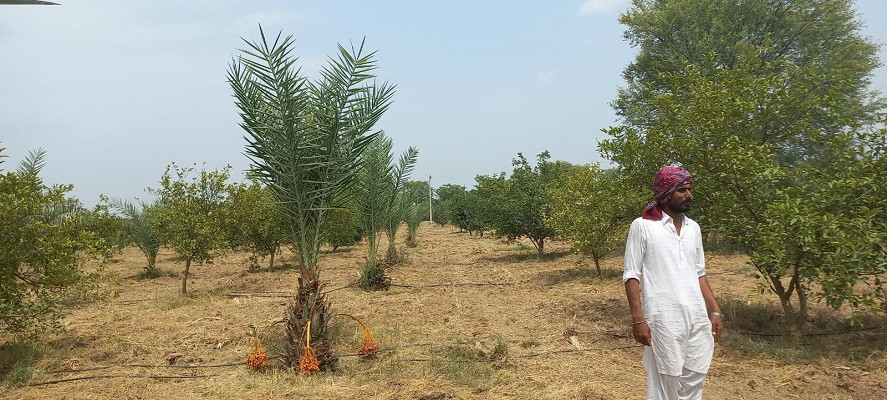
Agricultural experts and farmers believe that drip irrigation can increase crop yields and ensure food security besides conserving water in the areas where water resources are scarce.
This irrigation model allows farmers to grow crops by using less water than the traditional method of flooding. The system is being examined by institutes as a model while many farmers, specifically some fruit and vegetable growers who are targeting sustainable farming, have adopted it for watering their orchards.
“Drip irrigation is not a substitute for other proven methods of irrigation. It is just another way of applying water. It is best suited for areas where water quality is marginal, land is steeply sloping or undulating and of poor quality, where water or labour is expensive, or where high-value crops require frequent water applications,” said agronomist Dr Jamshaid Ahmad, Farm Manager at the University of Veterinary and Animal Sciences (UVAS), Ravi Campus Pattoki.
The drip irrigation system installed on the UVAS Ravi campus is funded by Nestle Pakistan.
Given Pakistan’s water scarcity challenges, the adoption of drip irrigation can play a significant role in sustainable agriculture and water conservation efforts. There is around 30-40% more production in drip irrigation system vs the conventional method. Besides, it saves 40-60% of water wastage through conventional flooding.
It is also a swift hydrating method of dripping water onto the soil at very low rates (2-20 litres/hour) from the system which involves wetting the whole soil profile. Applications are more frequent and usually on every one to three days, while saves considerable labour cost, the agronomist added.
How tiny little water drops can save crop life and conserve water in the region, enhance crop health and could forever change the entire agriculture landscape, especially in resource-starved environments, is literally not a magic, but a vital requirement on the bone-dry rural flank of Pakistan.
“When there is no or less than a quarter inch of rain, irrigation is a must for all fields and orchards to grow on a system set up on a pretty outdated flood irrigation system,” said an advocate of smart farming, Mustapha Yousaf.
Yousaf owns a progressive agriculture farm near Sheikhupura, growing fresh and wholesome seasonal produce. Some 60% cost of my drip irrigation system has been funded by the government of Punjab under the World Bank’s subsidy scheme “Punjab Irrigated – Agriculture Productivity Improvement Project.” Remaining 40% was covered by the Nestle Pakistan.
A network of black plastic tubing can be seen snaking down hundreds of rows of guava in his orchard, an experiment that could radically reduce the farm’s dependence on costly watershed. “Even if canals supply enough water, flooding wastes huge volumes of water while overwhelming the root can damage the plant health,” he remarked.
In a positive aspect, the dripping can save 30-40% water used in conventional flooding method. It helps apply targeted nutrition that makes plant healthier than its development through other methods. “Healthy plants can resist diseases and saves 50% fertiliser/ production cost, especially when applying targeted fertiliser like urea through drip,” Yousaf said.
It is suitable for crops like fruits and vegetable, but absolutely not suitable for field crops. Water requirement is based on the age of the plant. “I am streaming about 16 litres of water to hydrate each of guava plant,” he added.
Flood irrigation has hung on globally because it is cash cheap. However, from a natural-resource perspective, it is staggeringly expensive.
In Pakistan, agriculture is the largest consumer of freshwater, consuming over 90% of the resource, while more than 50% is lost unused due to unsustainable farming methods. Besides, overwatered crops can fail to reach their full potential while excess fertiliser is carried away by the runoff to contaminate the streams of water resources.
In an opposing portrayal, Sindh Abadgar Board Vice President Syed Mehmood Nawaz Shah termed it an expensive method with high capital cost.
“World Bank-funded project that started years ago ended without much outcome. Its effective implementation is not possible without the government’s initiative,” Shah remarked.
Drip irrigation method is mostly installed on mango and banana orchards while some vegetable farmers are also practicing in Sindh. It is unclear how many farmers have installed privately.
“It is not about just changing the irrigation method, rather it is about changing the total agricultural practices and needs continuous government initiatives to generalise the method,” Shah argued.
JS Global agriculture sector analyst Waqas Ghani Kukaswadia observed that while the drip irrigation method offers various benefits, it also presents certain challenges. Equipment for the method demands a higher initial investment than conventional methods. Nevertheless, the substantial savings over the time typically outweigh this expense.
Funds and interventions
Pakistan faces a severe water crisis that threatens the nation’s long-term food security. The country needs to expand area under cultivation while efficiently managing its precious water resources.
Earlier, the World Bank also initiated high-efficiency irrigation projects to further boost the agriculture activity in Pakistan. The World Bank collaborated on a 60-40% basis with the provincial governments.
It partnered with Punjab government for Punjab Irrigated Agriculture Productivity Improvement Project (PIPIP). It also partnered with the Sindh government for Sindh Irrigated Agricultural Productivity Enhancement Project (SIAPEP).
Major multinational players like Nestle Pakistan are helping farmers to conserve water by improving water use efficiency in their direct agricultural supply chain.
Under the initiative, Nestle covered 40% of the cost of putting up the equipment while the Punjab government covered the remaining 60% expenses through the World Bank programme.
Nestle with Centre for Water Informatics and Technology (WIT), LUMS has developed low-cost smart soil moisture sensors. These sensors read the moisture level of the soil and send regular data updates to a cloud from where the farmer receives information about which areas they should irrigate and how much, Rahat Hussain, a spokesperson for Nestle Pakistan said while talking to The Express Tribune.
Published in The Express Tribune, August 25th, 2023.
Like Business on Facebook, follow @TribuneBiz on Twitter to stay informed and join in the conversation.
















1730706072-0/Copy-of-Untitled-(2)1730706072-0-270x192.webp)
COMMENTS
Comments are moderated and generally will be posted if they are on-topic and not abusive.
For more information, please see our Comments FAQ